-
 Bitcoin
Bitcoin $115200
-2.56% -
 Ethereum
Ethereum $3619
1.19% -
 XRP
XRP $3.066
0.63% -
 Tether USDt
Tether USDt $1.000
-0.05% -
 BNB
BNB $759.4
0.45% -
 Solana
Solana $177.0
-3.28% -
 USDC
USDC $1.000
-0.03% -
 Dogecoin
Dogecoin $0.2254
-2.67% -
 TRON
TRON $0.3146
2.97% -
 Cardano
Cardano $0.7939
1.40% -
 Hyperliquid
Hyperliquid $42.05
-0.56% -
 Stellar
Stellar $0.4140
0.36% -
 Sui
Sui $3.641
0.05% -
 Chainlink
Chainlink $17.42
-1.08% -
 Bitcoin Cash
Bitcoin Cash $525.2
4.81% -
 Hedera
Hedera $0.2367
-0.15% -
 Avalanche
Avalanche $23.06
-0.42% -
 Litecoin
Litecoin $111.3
1.23% -
 UNUS SED LEO
UNUS SED LEO $8.970
-0.31% -
 Shiba Inu
Shiba Inu $0.00001330
-0.25% -
 Toncoin
Toncoin $3.092
-0.55% -
 Ethena USDe
Ethena USDe $1.001
-0.04% -
 Polkadot
Polkadot $3.934
-1.53% -
 Uniswap
Uniswap $9.948
0.56% -
 Monero
Monero $322.7
2.58% -
 Dai
Dai $0.0000
-0.01% -
 Bitget Token
Bitget Token $4.440
-2.75% -
 Pepe
Pepe $0.00001199
-2.25% -
 Aave
Aave $285.6
0.78% -
 Cronos
Cronos $0.1294
6.68%
그래픽 카드 마이닝을 채굴 풀에 추가해야합니까?
수익성있는 GPU 채굴의 경우 수영장에 가입하는 것이 필수적입니다. 솔로 채굴은 암호화 퍼즐을 성공적으로 해결할 확률이 낮기 때문에 매우 어렵고 종종 수익성이 없습니다. 낮은 수수료와 신뢰할 수있는 지불금을 가진 평판이 좋은 풀을 선택하는 것은 일관된 수입에 중요합니다.
2025/03/06 09:18
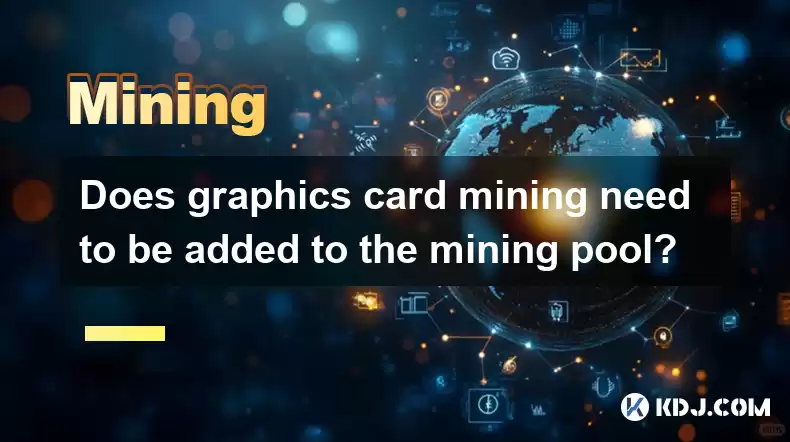
핵심 사항 :
- 그래픽 카드 채굴은 효율적인 수익성을 위해 광업 풀에 가입해야합니다.
- GPU를 사용한 솔로 채굴은 일반적으로 복잡한 암호화 퍼즐을 해결하기가 어렵 기 때문에 일반적으로 수익성이 없습니다.
- 풀에 가입하면 광업 워크로드가 배포되고 비례 적으로 보상을 공유합니다.
- 평판이 좋은 풀을 선택하는 것은 보안 및 일관된 지불금에 중요합니다.
- 수수료, 지불 방법 및 서버 위치를 포함하여 몇 가지 요소가 풀 선택에 영향을 미칩니다.
그래픽 카드 마이닝을 채굴 풀에 추가해야합니까?
짧은 대답은 다음과 같습니다. 예, 거의 모든 실용적인 목적을 위해서는 성공적이고 수익성있는 GPU 채굴을 위해서는 마이닝 풀에 그래픽 카드를 추가하는 것이 필요합니다. 단일 광부가 암호화 퍼즐을 독립적으로 해결하려고 시도하는 솔로 채굴은 엄청나게 어렵고 종종 GPU의 수수료가 부족합니다. 블록 솔로를 성공적으로 채굴 할 가능성은 특히 대부분의 암호 화폐의 어려움이 증가함에 따라 매우 얇습니다.
광업 풀에 가입하는 이유는 무엇입니까? 채굴 풀은 많은 광부의 해싱 파워를 집계합니다. 이것은 블록을 해결하고 보상을받을 확률을 크게 증가시킵니다. 각 광부가 독립적으로 일하고 잠재적으로 몇 주 또는 몇 달을 대기하는 대신 지불금을 기부 한 해시 전력에 따라 회원들 사이에 보상을 공유합니다. 이 "비례 지불금"시스템은 일관된 소득을 보장합니다.
광업 풀에 GPU를 추가하면 어떻게 작동합니까? 프로세스에는 일반적으로 다음 단계가 포함됩니다.
- 광업 풀 선택 : 수수료, 지불 빈도 및 서버 위치와 같은 요소에 따라 평판이 좋은 풀을 연구하고 평판이 좋은 풀을 선택하십시오. 빈번한 블록 솔루션의 기회가 높을 수 있도록 큰 해시 레이트가있는 수영장을 고려하십시오.
- 마이닝 소프트웨어 얻기 : 그래픽 카드 및 선택한 수영장과 호환되는 적절한 마이닝 소프트웨어를 다운로드하여 설치하십시오. 인기있는 선택으로는 Claymore의 듀얼 광부, Teamredminer 및 Phoenixminer가 있습니다.
- 광부 구성 : 풀 주소, 지갑 주소 및 작업자 이름 (채굴 장비의 고유 식별자)으로 채굴 소프트웨어를 구성하십시오.
- GPU를 연결하십시오 : 채굴 소프트웨어를 시작하십시오.이 소프트웨어는 자동으로 GPU를 사용하여 풀의 해시 레이트에 기여합니다.
- 진행 상황 모니터링 : 채굴 소프트웨어 및 풀 통계를 정기적으로 모니터링하여 기부금 및 수입을 추적하십시오.
올바른 광업 풀을 선택하는 것이 중요한 단계입니다. 이러한 측면을 고려하십시오.
- 수영장 수수료 : 대부분의 수영장은 수입에 대해 수수료 (일반적으로 1-3%)를 청구합니다. 비용 효율적인 옵션을 찾으려면 다른 수영장의 수수료를 비교하십시오.
- 지불 방법 : 풀은 인스턴트 지불금, 예약 지불금 또는 최소 지불 임계 값과 같은 다양한 지불 방법을 제공합니다. 선호도 및 채굴 설정에 적합한 메소드를 선택하십시오.
- 서버 위치 : 서버가 지리적으로 더 가까운 서버를 선택하면 대기 시간을 줄이고 채굴 효율성을 향상시킬 수 있습니다. 핑이 낮을수록 수영장과의 의사 소통이 빠르고 잠재적으로 더 높은 수입을 의미합니다.
- 수영장 해시 레이트 : 더 큰 수영장은 일반적으로 블록을 더 자주 찾을 가능성이 높으므로 더 자주 지불금을받습니다. 그러나 매우 큰 수영장은 해싱 전력 단위당 경쟁이 높고 수익성이 약간 낮아질 수 있습니다.
- 수영장 안정성 및 평판 : 신뢰할 수있는 지불금과 최소한의 다운 타임에 대한 입증 된 실적이있는 수영장을 찾으십시오. 리뷰를 읽고 커뮤니티 포럼을 확인하여 다양한 수영장에 대한 피드백을 확인하십시오.
마이닝 소프트웨어 자체는 중요한 구성 요소입니다. 이 프로그램은 GPU의 처리 능력을 효율적으로 활용하여 광업에 필요한 복잡한 수학 계산을 수행하도록 설계되었습니다. 다양한 소프트웨어 옵션은 다양한 GPU 아키텍처 (AMD 또는 NVIDIA)에 최적화되며 일부는 오버 클로킹 지원 또는 백업 풀에 자동 장애 조치와 같은 고급 기능을 제공합니다.
보안도 주요 관심사입니다. 공식 소스에서 마이닝 소프트웨어를 다운로드하여 악성 코드를 피하십시오. 피싱 시도에주의를 기울이고 수영장 담당자를 포함한 모든 사람과 개인 키나 지갑 시드 문구를 공유하지 마십시오. 마이닝 소프트웨어에 입력하기 전에 항상 풀 주소를 다시 확인하여 수입을 잘못된 장소로 보내지 않도록하십시오.
자주 묻는 질문 :
Q : 수영장에서 채굴하는 동안 GPU가 실패하면 어떻게됩니까? A : 대부분의 평판이 좋은 풀에는 광부 단절을 처리하는 메커니즘이 있습니다. 실패 전 기부금에 따라 수입이 계산되며 GPU가 다시 운영되면 채굴을 재개 할 수 있습니다.
Q : 수영장에 하나의 GPU로 여러 cryptocurrencies를 채굴 할 수 있습니까? A : 예, 일부 채굴 소프트웨어를 사용하면 풀에서 채굴되는 다른 암호 화폐 사이를 전환 할 수 있습니다. 그러나 일반적으로 각각의 다른 동전에 대한 광부 설정을 재구성해야합니다.
Q : 채굴 풀은 얼마나 자주 보상을 지불합니까? A : 지불 빈도는 풀에 따라 다릅니다. 일부 풀은 즉시 지불금을 제공하는 반면, 다른 풀은 예약 된 지불금 (예 : 매일, 주간) 또는 최소 지불 임계 값을 예약했습니다.
Q : 광업 풀에 가입하는 것과 관련된 위험이 있습니까? A : 그렇습니다. 평판이 좋은 수영장은 그러한 관행에 참여할 가능성이 적지 만 수영장 운영자 부정직의 위험이 있습니다. 또한 풀 가동 중지 시간의 위험이있어 채굴 활동을 일시적으로 방해 할 수 있습니다.
Q : 성능이 좋지 않은 채굴 풀을 선택하면 어떻게됩니까? A : 성능이 좋지 않은 수영장은 블록을 찾을 가능성이 낮아서 지불금이 자주 또는 작아 질 수 있습니다. 또한 수수료가 높거나 신뢰할 수없는 지불금이있을 수도 있습니다. 다른 수영장으로 전환하는 것은 항상 옵션입니다.
Q : 수영장에 가입하지 않고 채굴 할 수 있습니까? A : 그렇습니다. 광산을 솔로 할 수는 있지만 특히 어려움이 많고 블록을 찾을 확률이 낮기 때문에 GPU의 수익성이 거의 없을 것입니다.
Q : 광업 풀에서 수익성을 결정하는 요인은 무엇입니까? A : 귀하의 수익성은 GPU의 해시 요금, 수영장 수수료, 암호 화폐 가격 및 네트워크의 어려움과 같은 요소에 의해 결정됩니다.
부인 성명:info@kdj.com
제공된 정보는 거래 조언이 아닙니다. kdj.com은 이 기사에 제공된 정보를 기반으로 이루어진 투자에 대해 어떠한 책임도 지지 않습니다. 암호화폐는 변동성이 매우 높으므로 철저한 조사 후 신중하게 투자하는 것이 좋습니다!
본 웹사이트에 사용된 내용이 귀하의 저작권을 침해한다고 판단되는 경우, 즉시 당사(info@kdj.com)로 연락주시면 즉시 삭제하도록 하겠습니다.
- 비트 코인 스위프트 (BTC3) : 사전 판매 단계 1에 대한 마지막 호출!
- 2025-07-25 23:10:12
- 10 년의 알트 코인 : 상위 3 개의 암호화 타이탄 발사
- 2025-07-25 23:50:11
- Bitcoin, Presales 및 Crypto Bueys : NYC Crypto 장면에서 무엇이 뜨거운가?
- 2025-07-25 23:50:11
- Blockdag, Link 및 Uniswap : 실제 유틸리티로 암호화 조경 탐색
- 2025-07-25 23:55:12
- 타이어 합법성 및 20P 코인 테스트 : 자동차 전문가가 알고 싶어하는 것
- 2025-07-25 23:55:12
- 스포트라이트의 Altcoins : Solana, Unilabs 및 Bull Run Buzz
- 2025-07-26 00:00:24
관련 지식
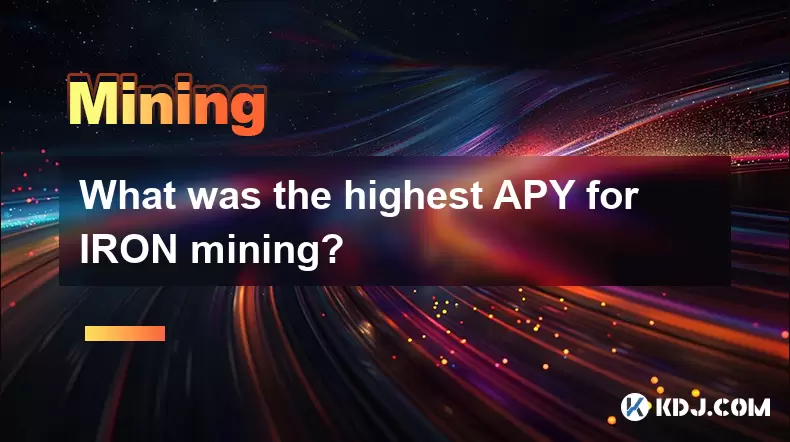
철 채굴의 가장 높은 Apy는 무엇입니까?
2025-07-23 05:14:36
철 토큰과 채굴 메커니즘을 이해합니다 Iron Token 은 철제 금융 생태계 내에서 작동하는 스타블 레코 인이며, 주로 Polygon 및 Binance Smart Chain과 같은 블록 체인 네트워크에서 작동합니다. 그것은 부분 담보 모델을 통해 미국 달러로 1 : ...

철 풀에서 불완전한 손실은 무엇입니까?
2025-07-23 09:00:41
철 풀의 맥락에서 불완전한 손실을 이해합니다 불완전한 손실은 분산 금융 (DEFI) 플랫폼, 특히 자동화 된 시장 제조업체 (AMM) 모델을 사용하는 유동성 제공 업체에 영향을 미치는 현상입니다. 철제 금융 생태계 의 일부인 철 풀의 맥락에서, 유동성 풀에 추가 된 후...
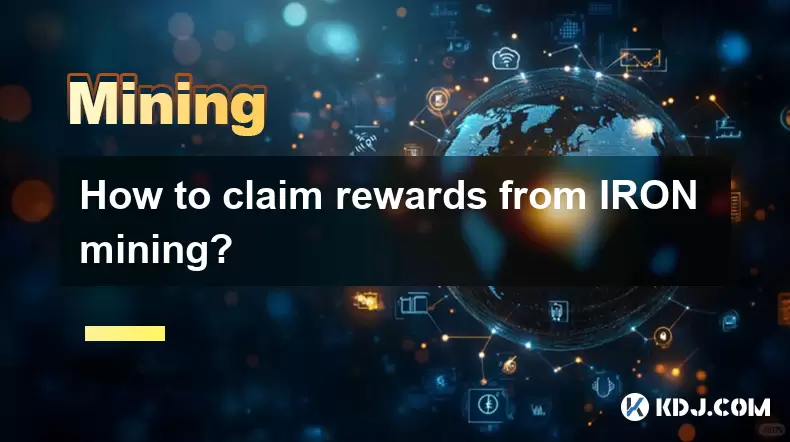
철 채굴로부터 보상을 청구하는 방법?
2025-07-23 14:21:39
철 채굴 및 보상 메커니즘 이해 Iron Finance는 다각형 및 Binance 스마트 체인 네트워크에서 분산 된 금융 (Defi) 프로토콜로 운영되어 철 및 타이탄 으로 구성된 이중 토로 시스템을 도입했습니다. 이 프로토콜을 통해 사용자는 지정된 풀에 자산을 제공하...
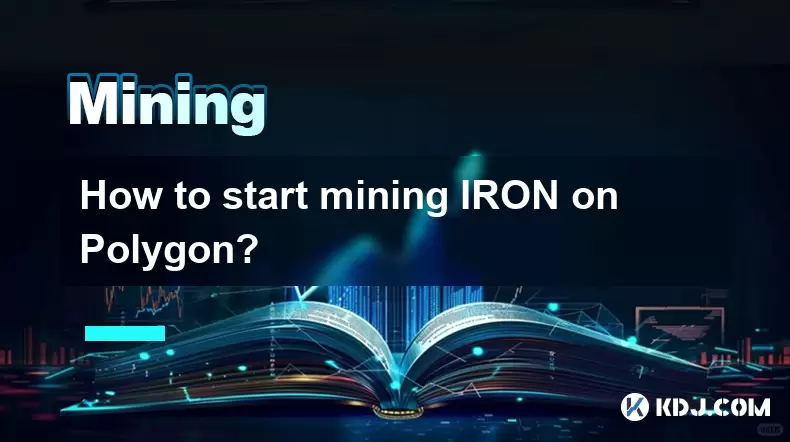
다각형에서 철분을 채굴하는 방법?
2025-07-23 20:00:37
철분과 다각형에 대한 역할을 이해합니다 철은 미국 달러로 1 : 1 페그를 유지하도록 설계된 분산 된 알고리즘 스타블 코인입니다. 다각형 (이전의 Matic Network)을 포함한 여러 블록 체인 네트워크에서 운영되며, 이는 낮은 트랜잭션 수수료와 높은 처리량을 제공...
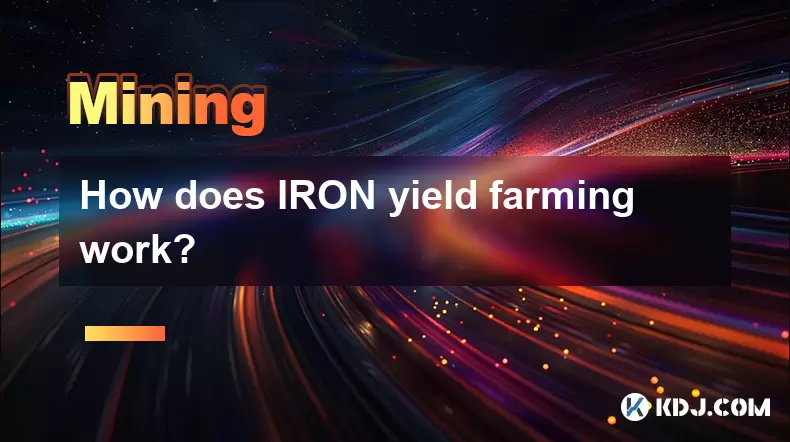
아이언은 어떻게 농업을 생산합니까?
2025-07-23 22:14:36
철률 농업 및 핵심 메커니즘을 이해합니다 철 생산량 농업은 블록 체인 플랫폼의 특정 토큰 풀에 유동성을 제공함으로써 사용자가 보상을받을 수있는 분산 된 금융 (DEFI) 전략입니다. Iron Token 은 일반적으로 Iron Finance Ecosystem과 관련이 있...
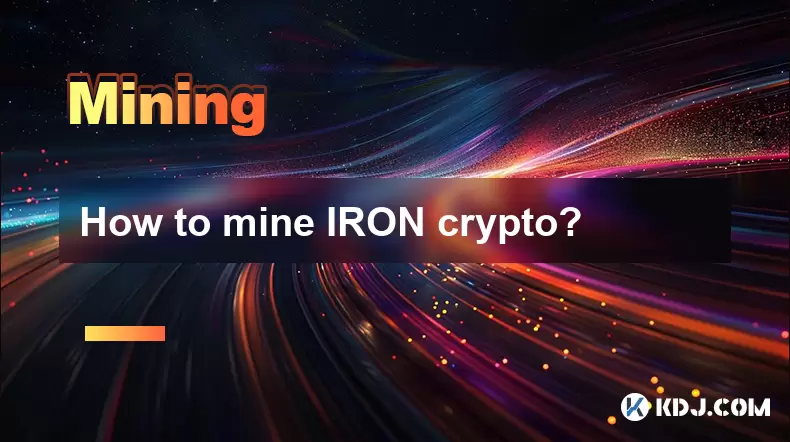
아이언 크립토를 채굴하는 방법?
2025-07-23 19:08:01
아이언 암호화 및 마이닝 메커니즘을 이해합니다 Iron Crypto는 전통적인 작업 증명 (POW) 방법을 사용하여 채굴 할 수있는 독립형 블록 체인 기반 암호 화폐가 아닙니다. 대신, Iron 은 다중 생태계 에서 작동하는 합성 안정식으로, 주로 미국 달러에 비해 안...

철 채굴의 가장 높은 Apy는 무엇입니까?
2025-07-23 05:14:36
철 토큰과 채굴 메커니즘을 이해합니다 Iron Token 은 철제 금융 생태계 내에서 작동하는 스타블 레코 인이며, 주로 Polygon 및 Binance Smart Chain과 같은 블록 체인 네트워크에서 작동합니다. 그것은 부분 담보 모델을 통해 미국 달러로 1 : ...

철 풀에서 불완전한 손실은 무엇입니까?
2025-07-23 09:00:41
철 풀의 맥락에서 불완전한 손실을 이해합니다 불완전한 손실은 분산 금융 (DEFI) 플랫폼, 특히 자동화 된 시장 제조업체 (AMM) 모델을 사용하는 유동성 제공 업체에 영향을 미치는 현상입니다. 철제 금융 생태계 의 일부인 철 풀의 맥락에서, 유동성 풀에 추가 된 후...

철 채굴로부터 보상을 청구하는 방법?
2025-07-23 14:21:39
철 채굴 및 보상 메커니즘 이해 Iron Finance는 다각형 및 Binance 스마트 체인 네트워크에서 분산 된 금융 (Defi) 프로토콜로 운영되어 철 및 타이탄 으로 구성된 이중 토로 시스템을 도입했습니다. 이 프로토콜을 통해 사용자는 지정된 풀에 자산을 제공하...

다각형에서 철분을 채굴하는 방법?
2025-07-23 20:00:37
철분과 다각형에 대한 역할을 이해합니다 철은 미국 달러로 1 : 1 페그를 유지하도록 설계된 분산 된 알고리즘 스타블 코인입니다. 다각형 (이전의 Matic Network)을 포함한 여러 블록 체인 네트워크에서 운영되며, 이는 낮은 트랜잭션 수수료와 높은 처리량을 제공...

아이언은 어떻게 농업을 생산합니까?
2025-07-23 22:14:36
철률 농업 및 핵심 메커니즘을 이해합니다 철 생산량 농업은 블록 체인 플랫폼의 특정 토큰 풀에 유동성을 제공함으로써 사용자가 보상을받을 수있는 분산 된 금융 (DEFI) 전략입니다. Iron Token 은 일반적으로 Iron Finance Ecosystem과 관련이 있...

아이언 크립토를 채굴하는 방법?
2025-07-23 19:08:01
아이언 암호화 및 마이닝 메커니즘을 이해합니다 Iron Crypto는 전통적인 작업 증명 (POW) 방법을 사용하여 채굴 할 수있는 독립형 블록 체인 기반 암호 화폐가 아닙니다. 대신, Iron 은 다중 생태계 에서 작동하는 합성 안정식으로, 주로 미국 달러에 비해 안...
모든 기사 보기

























































































